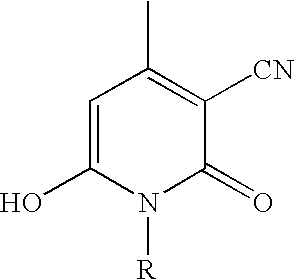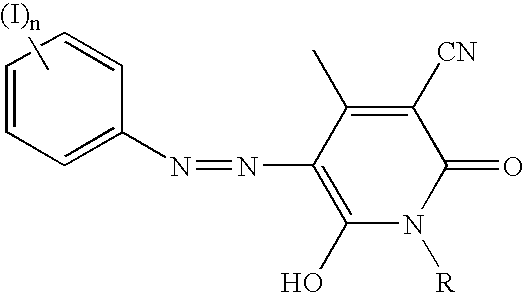Methods of preparing aqueous colored pigment dispersions, and inkjet ink compositions
a technology of colored pigment and dispersions, which is applied in the direction of azo dye coupling reaction, application, inks, etc., can solve the problem that pigments alone are not readily dispersed in liquid vehicles
- Summary
- Abstract
- Description
- Claims
- Application Information
AI Technical Summary
Problems solved by technology
Method used
Image
Examples
example 1
[0054]A rotor-stator high shear mixer (Silverson L4RT-A) was fitted with a 4 liter stainless steel beaker and was immersed in an ice bath. Approximately 75 g of Pigment Yellow 74 and 1000 g of water were placed into the beaker and the mixture was homogenized for 15 min at 7,200 rpm. To this was added a solution of 2.07 g (0.01 mol) of acetoacet-o-anisidide in 20 mL of isopropanol, and the mixture was stirred for an additional 15 minutes.
[0055]In a separate vessel, 4.35 g (0.025 mol) of sulfanilic acid were mixed with 30 ml 1 N HCl and 1.73 g (0.025 mol) of sodium nitrite at 5–10 degrees C., forming the corresponding diazonium salt. This was then added to the mixture of Pigment Yellow 74 and acetoacet-o-anisidide, with stirring. The temperature was maintained at approximately 10 degrees C. The mixture was adjusted to a pH of 5–6 by dropwise addition of a 5M sodium hydroxide solution. Mixing was continued for an additional 2 hours. The reaction progress was monitored by removing small...
example 2
[0058]A rotor-stator high shear mixer (Silverson L4RT-A) was fitted with a 4 liter stainless steel beaker, and was immersed in an ice bath. Approximately 75 g of Pigment Yellow 74 and 1000 g of water were placed into the beaker and the mixture was homogenized for 15 min at 7,200 rpm. A solution of 3.85 g of Compound I shown below (prepared by azo coupling of the diazonium salt of sulfanilic acid with acetoacet-o-anisidide at pH 4.5–6.0 using a 1:1 molar ratio of diazonium salt to azo coupler) in 200 ml of water was then added.
[0059]
The mixture was then stirred for an additional 2 hours.
[0060]The mixture was transferred to a Telsonic flow-through sonicator and sonicated for 2 hours, to produce an aqueous colored pigment dispersion. The resulting yellow pigment dispersion was purified using a 50 nm diafiltration membrane column and concentrated to solids content of 10%. The median particle size of the bright yellow dispersion was about 150 nm.
[0061]This example shows an embodiment of ...
example 3
[0062]Compound 2, shown below, was prepared using the following procedure. Sulfanilic acid (0.1 mol) was diazotized by consecutive additions of 125 mL of 1N HCl and 50 mL of a 2M sodium nitrite solution at 0–5 degrees C. The resulting suspension of diazonium salt was added to a 0.1M solution of Naphthol AS-CA (2 methoxy-5-chloroanilide of 2-hydroxy-3-naphthoic acid) in 100 mL of 1M NaOH mixed with 300 g of ice. Coupling was conducted at pH 5–6, which was maintained by gradual addition of 50 g of solid sodium acetate.
[0063]
Compound 2, formed in the reaction, was isolated by centrifugation and recrystallized from isopropanol / water (1 / 1).
[0064]Compound 2 (0.2 g) was dissolved in 500 mL of hot water, and the solution was cooled down to 25–30 degrees C. Approximately 4 g of Pigment Red 269 (Sunbrite Red 435–4438, available from Sun Chemicals Corporation, Cincinnati, Ohio) was added and the mixture homogenized in a Silverson rotor-stator mixer for 30 minutes. The resulting maroon dispersi...
PUM
 Login to View More
Login to View More Abstract
Description
Claims
Application Information
 Login to View More
Login to View More - R&D
- Intellectual Property
- Life Sciences
- Materials
- Tech Scout
- Unparalleled Data Quality
- Higher Quality Content
- 60% Fewer Hallucinations
Browse by: Latest US Patents, China's latest patents, Technical Efficacy Thesaurus, Application Domain, Technology Topic, Popular Technical Reports.
© 2025 PatSnap. All rights reserved.Legal|Privacy policy|Modern Slavery Act Transparency Statement|Sitemap|About US| Contact US: help@patsnap.com



